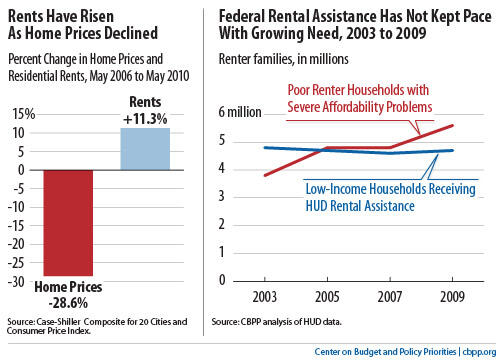off the charts
POLICY INSIGHT
BEYOND THE NUMBERS
BEYOND THE NUMBERS
Housing Affordability Problems Worsening for Poor Renters
Receive the latest news and reports from the Center
Housing has become increasingly unaffordable for low-income renters since the start of the recession, according to fresh data from several sources:
What explains these alarming trends? Part of the story is that many poorer households’ incomes have fallen during the recession due to job losses, which has widened the gap between incomes and housing costs.
Yet recent changes in the housing market have done little to ease burdens on renters. While home prices have fallen by nearly 30 percent since the market peaked in 2006, residential rents have merely leveled off over the past year and are actually 11 percent higher now than in 2006, as the first chart shows.

While federal rental assistance programs have played an essential role in helping low-income families to find affordable housing, they have failed to keep pace with the rapidly growing need due to funding limitations, as the second chart shows. Indeed, as the number of poor renter families that pay more than half of their income for housing increased by 1.7 million from 2003 to 2009, the number of families receiving rental assistance actually declined slightly.
Last year’s Recovery Act provided $1.5 billion in emergency funds to help families who are homeless or at risk of becoming homeless to find or retain stable housing. Local housing agencies have begun to use these funds to mitigate the effects of the recession on homelessness.
Still, more help is clearly needed.